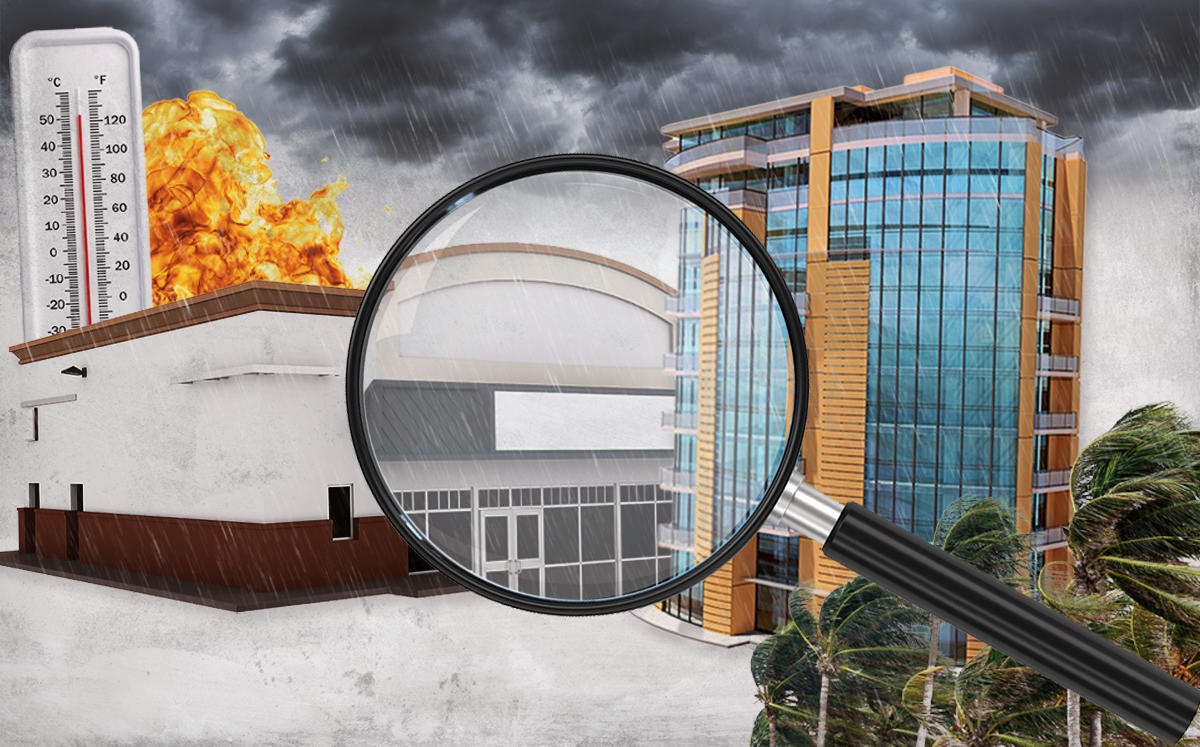UPDATED, Nov. 6, 2:31 p.m.: A $1.5 billion loan on a newly opened office building on Manhattan’s Far West Side faces high levels of risk from “heat and water stress.”
A $900 million mortgage on a portfolio of Los Angeles production studio and office buildings in Hollywood is subject to “red flag” levels of similar water stress.
A $410 million debt package on a life science facility in the Boston area faces red flag risk from rising sea-levels and flood potential, along with lower levels of heat stress, hurricane and wildfire risk.
Those are just a few examples of the kind of climate risk data that Moody’s recently began including in its ratings reports for CMBS transactions. It comes as the increasing frequency of wildfires, floods, hurricanes and other intense weather events have led to billions of dollars in property damage across the U.S.
The move to include climate risk metrics in CMBS ratings reports reflects a broader shift in the commercial real estate industry, with investors taking a closer look at the potential impact climate change may have on their assets.
Data firm Trepp has also moved to provide more clarity on climate-related risks to its customers recently. It has integrated data from catastrophe risk company RMS into its platforms, and is reporting risk scores for properties with CMBS loans.
Moody’s data is based on global climate models created by Four Twenty Seven, whose climate risk analytics cover assets in 196 countries. Moody’s acquired a majority stake in Four Twenty Seven over the summer.
In addition to the most evident risks like rising sea levels, floods and hurricanes, Four Twenty Seven also considers the risk presented by heat waves, which can disrupt business and increase energy bills, and water shortages, which can threaten the operation of power plants and other utilities.
For now, Four Twenty Seven’s risk scores don’t have a direct impact on Moody’s ratings models. But the company uses the information “to zero in on areas that have a higher likelihood of experiencing worsening conditions in terms of severe climate hazards,” said CMBS ratings group senior analyst Kevin Fagan.
Fagan said Moody’s does not assess a credit penalty for a loan attached to a high-risk property “because we don’t yet have a way to clearly measure real impact on property revenue and value.” But he added, that will likely change “because we need to be able to calibrate what these risks ultimately are.”
A Trepp analysis found that California, Florida, Texas, Louisiana and Washington are the states with the most properties exposed to the potential double-whammy of economic distress and natural disaster. RMS’ risk factors also include earthquakes, which are not believed to be linked to climate change.
The trajectory of climate change risk in coming decades may also be affected by the outcome of the undecided presidential election. Joe Biden’s campaign has announced plans to invest $2 trillion into green research and development, with the goal of putting the U.S. on a path to net-zero carbon emissions by 2050. Donald Trump, meanwhile, has listed “clean water and air” among his priorities while also seeking to boost oil and natural gas production in the U.S. The Trump administration officially withdrew the U.S. from the 2015 Paris climate agreement on Nov. 4, the day after the election. Biden intends to rejoin it.
“Leading real estate investment managers and institutional investors are increasingly recognizing climate risk as a core real estate issue that is beginning to affect their decisions at the market level as well as at the asset level,” researchers with the Urban Land Institute wrote in their second annual climate risk report. The report was published last month in partnership with global real estate investment management firm Heitman.
Going mainstream
ULI’s report argues that the pandemic has also served to put “connections between environmental, social, and governance (ESG) issues and our economies into sharper focus.”
The report notes that Moody’s acquisition of 427 helped make physical climate vulnerability assessments “significantly more mainstream.” Such factors are also starting to play a role in pricing and decision making.
“Market-level and/or asset-level risk alone will not preclude us from making an investment in an asset or a geography,” Heitman’s head of global research said in the report. “However, we want to make sure pricing reflects an asset’s risk and opportunity and that risk mitigants are in place.” The investment manager also uses Four Twenty Seven data for its analyses.
Read more


“CMBS thus far has been resistant from environmental losses as a result of hurricanes, tornadoes, and the like,” wrote Manus Clancy, senior managing director at Trepp, in a recent blog post. “For the most part, insurance proceeds have covered the repayment of the loan or the replacement of the property with CMBS losses being negligible as a result.”
Mitigation math
Determining the economic impact of Four Twenty Seven risk scores has proven to be a complicated process, in part because of the various measures stakeholders — from individual property owners up to state and federal governments — can take to mitigate climate risk.
The risk scores “don’t take into account any type of mitigation,” Fagan said. “So at this stage they help point us in the right direction, and then we assess all the mitigants.”
In a recent blog post, Four Twenty Seven analyst Lindsay Ross noted that institutional investors realize that over a seven- to 10-year hold period, “the next buyer of their building is likely to be concerned by climate risk as well.” Some investors take a “high” or “red flag” risk score as a sign that more due diligence is needed for a property, she said. “Deal teams may be tasked to investigate asset-specific features that would make it more resilient to specific climate hazards,” Ross wrote. Those include whether the lowest floor has been raised above base flood elevation, and whether onsite power generators have been installed or water efficiency measures implemented, she noted.
One key mitigation element at the property level is insurance, especially in the case of the risk categories like hurricanes, floods and wildfires that can have clear impacts on the viability of a property.
While Moody’s isn’t using the wildfire scores for its ratings yet, “I would imagine that northeast L.A. would have red-flag scores for wildfires,” Fagan said. He added that “one thing that could bring down the value of an asset is the inability to get fire insurance on it.”
The question of fire insurance availability is a timely one in California. Last year, the state enacted a year-long ban to bar insurers from canceling policies on about 800,000 homes in or near areas with a high risk of wildfires. The measure was set to expire but on Nov. 5, the state Department of Insurance extended it another year, covering 2.1 million homeowners.
Energy-saving improvements to buildings, as well as government measures such as New York City’s proposed green buildings law or the construction of sea walls, may also help mitigate risks.
Moody’s has long accounted for factors like windstorm insurance and energy usage in its ratings.
Fagan, who has prior experience working as a structural engineer in Southern California, also noted that the all-encompassing nature of climate change makes it somewhat harder to grapple with, compared with more well-understood risks like earthquakes.
“It’s more a global problem than something individual property owners can address in as clear a way as, for example, ensuring your building can withstand an earthquake or isn’t built near a fault line.”
